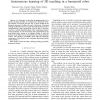Free Online Productivity Tools
i2Speak
i2Symbol
i2OCR
iTex2Img
iWeb2Print
iWeb2Shot
i2Type
iPdf2Split
iPdf2Merge
i2Bopomofo
i2Arabic
i2Style
i2Image
i2PDF
iLatex2Rtf
Sci2ools
99
Voted
IROS
2007
IEEE
2007
IEEE
Autonomous learning of 3D reaching in a humanoid robot
— In this paper, we describe the implementation of a precise reaching controller on an upper-torso humanoid robot. The solution we propose does not rely on prior models of the kinematic structure of either the arm or the head. A learning strategy enables the robot to acquire the required sensory-motor transformations. After learning the robot is able to precisely reach for a visually identified object in the 3-dimensional space. In this technique we use the fixation point (represented in the head joints motor space) as a reference frame to code the position of the object and to represent the eye-to-hand Jacobian matrix. This strategy successfully deals with the kinematic redundancy of the structure and constraints the dimensionality of the problem.
IROS 2007 | Precise Reaching Controller | Required Sensory-motor Transformations | Robotics | Upper-torso Humanoid Robot |
Related Content
| Added | 03 Jun 2010 |
| Updated | 03 Jun 2010 |
| Type | Conference |
| Year | 2007 |
| Where | IROS |
| Authors | Francesco Nori, Lorenzo Natale, Giulio Sandini, Giorgio Metta |
Comments (0)

